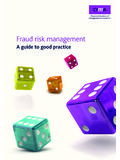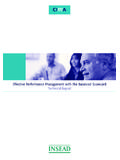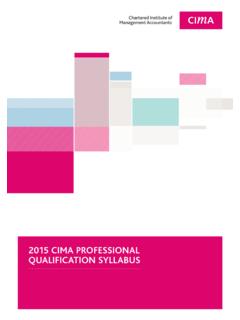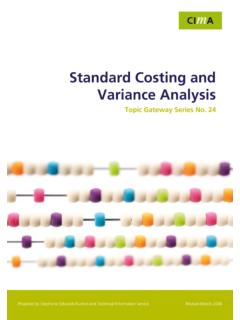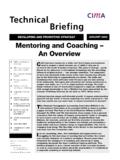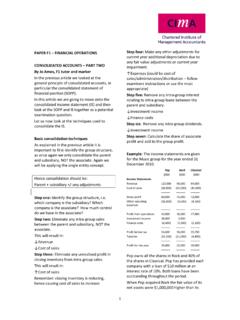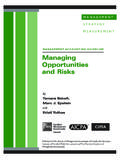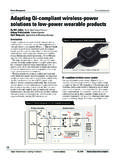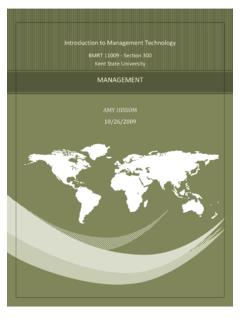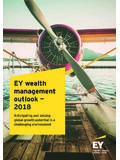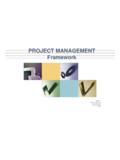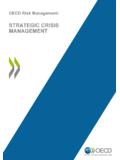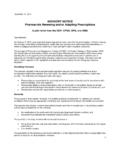Transcription of Drivers of risk management - CIMA - Chartered Institute of ...
1 Drivers of risk managementAdapting risk management to organisational motivesResearch executive summary series Volume 7 | Issue 7 Rune Yndestad M ller Copenhagen Business School1 | Drivers of risk management adapting risk management to organisational motivesMain findings, implications and overview of projectRisk management s official argument is clear: it is good business. However, practice does not indicate the same. Based on theory and case studies, the following Drivers for risk management have been identified: A progressive argument or driver of value creation. Three defensive arguments or Drivers of value preservation: The increasing production of risk in modern society, leading to an escalating experience of uncertainty and unpredictability. Risk management as a mechanism of response to increasing uncertainty.
2 Risk management as a mechanism to distribute responsibility and was concluded that value creation is not a fundamental driver for risk management , but instead it seems to be largely if not exclusively, driven by a defensive motive for value preservation . The suggestion is that this distinction can be used in a taxonomy guiding the development of risk management technology and how organisations can adapt their risk management approach to fit their own Drivers as shown in the table Identify key Drivers for risk management , based on theory and case studies. Present taxonomy to guide organisations in developing risk management according to their own management is a relatively young management technology. During the last ten years, it has evolved from a technical economic discipline with roots in insurance, finance and engineering into becoming a mantra which has permeated the regulatory and management domains.
3 But why has risk management evolved to such a comprehensive discourse?The official rationale is quite simple risk management contributes to organisational value creation. However, practice raises several paradoxes in relation to this explanation. First, risk management frameworks such as COSO promise to enable the company to understand, handle and counter the uncertainty of the future in order to aid organisational value creation. However, the recent crisis indicates the linkage is not that , the growth of regulatory risk management requirements is in conflict with the argument of value creation. This is because the need for regulatory requirements would be unnecessary if value creation were already implicated. If this was the case, these activities would be conducted voluntarily by the company, seeing risk management as one of the company s strategic choices of differentiation.
4 Since this is not the case, risk management must revolve from other motives at least to some are some of the apparent paradoxes that trigger this article. The article discusses the Drivers of risk management , based upon theory and two cases. We then present taxonomy for organisations to help adapt their risk management in accordance with their own key driverDefensive driverValue creatingValue preservingGoal seekingLoss avoidanceKnowledge searchingCalculativePossibility exploringDefensiveLeadership basedBureaucraticAssessment orientedControl orientedFuture mindedRetrospectiveEx-ante participation in decision processesEx-post justification of decisions2 | Drivers of risk management adapting risk management to organisational motivesMethodThe research project is based on seven longitudinal qualitative case studies conducted at Copenhagen Business School, two of which are reflected in this article.
5 This article is an executive summary and synthesis of two articles published in the Danish magazine konomistyring & Informatikk 2010 companiesAll case companies are among the largest in Denmark, and seen as front runners in the area of risk Transport is an internationally-listed group, primarily involved in transport but also in other business areas such as energy. The company has a risk aware cultural heritage from the founder. Structured enterprise-wide risk management was officially initiated in 2004 by CEO mandate, due to risk exposures and experiences at the company but also triggered by losses observed at other companies. Risk management was originally located in internal audit, but along with their new CEO in 2008, risk management changed to become more integrated in the decision processes throughout the company rather than being a siloed Pharma is an internationally-listed group in the pharmaceutical industry.
6 Systematic risk management was initiated in 1999 in relation to a risky de-mergers of a central business area, the increasing emphasis on risk management in the anglo-saxon world, and their own chairman s involvement in the Committee on Corporate Governance in Denmark. The initiative resulted in an internal risk management organisation. The company s risk management has over the past ten years matured from a bureaucratic approach to being integrated in business and decision driverThe economical argument of risk management can be understood in the context of Weber s thesis of rationality. Weber (1978) understood rationalisation as capitalistic cost-benefit calculation. He argued that in the capitalistic system, the role of bureaucracy would increase and there would be a tendency to measure and plan everything, including the future.
7 This can be associated with the thesis of risk management , creating a basis for informed decisions. Weber did not deal with risk management as a modern tool, but certain aspects of his theory, such as rational value creation through bureaucratisation, can provide a qualified input on central Drivers for the growth of modern risk the quote from the former head of group staff functions in Transport indicates that rational value creation may not be the key driver for risk management . I have never understood risk management as value creating. We used risk management to avoid unexpected surprises, losses and negative impact on our set goals. According to one director, risk management was triggered by an expensive error in a larger African business, which we could definitively have prepared and risk assessed much better.
8 Our division was also aware of the Brent Spar and Piper Alfa cases in the late 1980s. All this in addition to the influence of consultancy companies, caused the CEO s directive. All told, there are few indications of a value creating risk management perspective in Transport, even though their risk management was explicitly said to be part of decision Pharma, risk is defined as events which can hinder the company from reaching overall goals. Risk management therefore seems to be value preserving rather than value creating. However, several interviewees argued their utmost ambition was to create increased transparency and improve the quality of decision processes. The head of risk management even said, the relation to decision processes has become more evident over time. Pharma initially emphasised loss avoidance, but they have begun to develop the relation between risk management and decision processes more strongly by exploring the uncertainty within decisions, which suggests more of a value creating though the official argument for risk management is progressive value creation, there are only a few explicit expressions of progressive Drivers in the empirical data that we came across in our case sites.
9 There are some implicit indications, but the Weberian arguments only partially explain the use of risk management . At best, the evidence suggests risk management approaches may be a result of process rationality (March, 2005). Process rationality is when decisions become meaningful due to the process, rather than the outcome. This is indeed a relevant argument if risk management is intended to create legitimacy and compliance. As such, doing risk management may be rational in a compliance sense even if initially purely | Drivers of risk management adapting risk management to organisational motivesDefensive driversThere are possibly larger social changes behind the growth of risk concerns and risk management . These changes increase the organisational need for risk management activities for other reasons than the value creation rationale.
10 These forces are likely defensive by being primarily reactive to external and internal productionGiddens (1999, ) defined the risk society as a society increasingly preoccupied with the future and safety, generating the notion of risk. Beck (1986) described the risk society as a post-modern society, where the logic of risk production dominates the logic of wealth production. Indeed, a central idea in Beck s (1997: 42, 37) risk society is the overproduction of which abundance should be prevented, eliminated, denied or reinterpreted. This thesis could, at least theoretically embed an obvious driver for the emergence of modern risk management is an attempt to anticipate causality and control the future. However, the problem is risk management does not necessarily imply it is possible to relate specific events and phenomena to specific reasons, because it is impossible, especially in a globalising world with increasing uncertainty and complexity, to identify the consequences of decisions before they are taken (Kneer & Nassehi, 1997).
